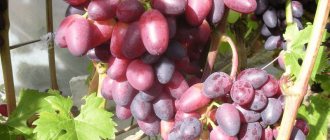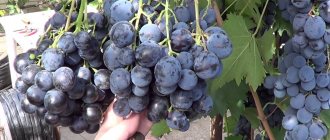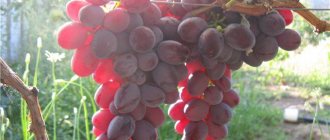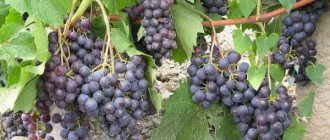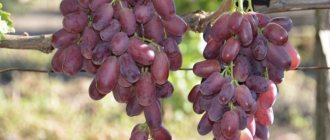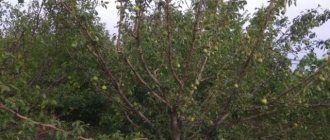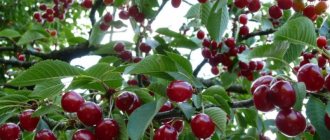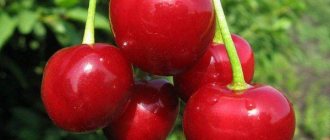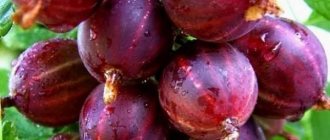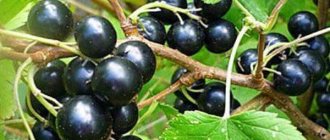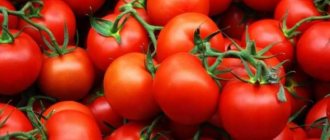Advantages and disadvantages
Before you decide to plant a variety, you need to know about all the pros and cons of growing it.
Pros:
- Good taste with moderate sweetness.
- High yield.
- Not prone to cracking.
- Resistant to fungal diseases.
- Good transportability.
- Unpretentiousness.
Minuses:
- The fruits are weakly attached to the ridge.
- Attractive to birds.
- Prone to overloading the vine.
Origin
The hybrid of tall grapes “Galahad” was bred relatively recently at the All-Russian Research Institute named after. ME AND. Potapenko. This hybrid, popular among gardeners, was created by Russian breeders by crossing grape varieties: “Talisman”, “Delight” and “Muscat Delight”.
The parents of “galahad” are “talisman”, “delight” and “nutmeg delight”
Since 2007, this grape variety has become available for cultivation by amateur gardeners, who appreciated the new grapes. Every year “galahad” is gaining more and more popularity not only in Russia, but also among gardeners in neighboring countries.
Reproduction of the variety
To grow the Galahad grape variety on your plot, it is enough to purchase a seedling from a nursery that breeds plants in the region, but you can also grow a seedling yourself. Moreover, with this variety it will be quite easy. When pruned, almost any cutting turns into a seedling. Just put it in water and leave it in a warm place.
After the roots appear, the plant should be planted in a pot with nutritious soil and left until next year. In the spring, such a plant can be planted in open ground and, with proper care, get a strong and healthy bush.
Main characteristics
This grape variety was specially developed for cultivation in the temperate climate of Russia. To this end, breeders tried to make grapes with good frost resistance, high yields and the earliest period of berry ripening.
Ripening period
According to the period of fruit ripening, “Galahad” belongs to the very early grape varieties. A very short period passes from the beginning of bud bursting to fruit maturity - only 95-100 days.
In the south of Russia, harvesting begins in the last ten days of July. The middle zone lags slightly behind the hot regions and collects the fruits of “galahada” in the first ten days of August. More northern regions will have to wait a little and the grapes will ripen 10-15 days later than in the central region.
Practice has established that of all the formed fruits of a given variety, about 65-70% of the berries ripen.
Bush
Bushes of a hybrid form with a powerful trunk and well-developed shoots have high growth vigor. If you do not prune regularly and do not restrain the growth of the vine, it can reach enormous sizes within a season. To facilitate the care and processing of bushes, the length of the vine is usually limited to 3 meters.
Optimal for “galahada” is a standard-free fan molding of the vine. Powerful tall bushes of this hybrid form 6 or 8 branches over several years. This pruning will allow the vine to develop well, make caring for the vineyard easier and provide convenient shelter for the vine for the winter.
Reference! In the southern regions, the vine can be formed into arbors or arches, because in hot climates there is no need to cover the vines for the winter.
bunches
Large clusters of hybrid form ripen weighing from 600 g to 1.2 kg. The brushes are well built, of medium looseness and have a cylindrical-conical shape.
One of the disadvantages of “galahad” is the rather weak attachment of the fruit to the ridge. If you leave the harvest on the bushes, you can lose a large number of berries. Therefore, it is very important not to hesitate and collect ripe bunches of grapes on time. It is recommended not to keep ripe grapes on the bushes for more than 2 weeks. It is better to collect them and store them in a cool, dry place.
Berries
Large, oval, elongated fruits weigh about 10 grams, sometimes reaching a weight of 15 grams. Unripe berries are milky green in color. As they ripen, they acquire an amber-yellow color. However, shaded berries may not change color and remain milky green. The fruits tolerate the hot sun well and do not bake, but tanned spots that appear in the sun can slightly spoil the appearance.
Under the thin but rather dense skin there is elastic pulp with 3-4 rather large seeds.
Sugar content of berries is 18-21%. Acidity - 5-6 g/l.
Taste
“Galahad” has a simple, harmonious, fresh and moderately sweet taste. According to tasters, it deserves 8.9 points out of 10. The berries become sweetest in the last week of ripening.
Despite the rather strong skin, it is practically not felt when eating grapes.
Productivity
With a good level of agricultural technology, an adult “galahada” bush can produce 15-20 kg of harvest. Young vines that are just beginning to bear fruit should be especially strictly limited in fruiting and the number of bunches per vine should be normalized.
Due to the resistance of the berries to cracking, the hybrid tolerates even prolonged rains during the ripening of the crop. The thick skin protects against insects and prevents wasps from damaging the fruit.
What can he do to please?
It is impossible to really imagine all the advantages of the variety. It needs to be experienced over the years, and, unfortunately, due to youth, this is impossible to do. But winegrowers already know about some of its advantages. And they share them with us:
- High and stable yield.
- Good immunity. It is rarely affected by grape plagues such as mildew and gray rot.
- Frost resistance. Without covering, a plant shoot can withstand temperatures dropping to -25 C. If it is covered, then the grapes can be preserved even at lower temperatures.
- Protection from mechanical damage. The dense shell protects the pulp from damage during transportation.
- Easy to care for. This variety belongs to the “for lazy winegrowers” type. You don't need to take special care of it.
- The berries do not crack. The fruits respond well to waterlogging and do not begin to crack.
Thanks to these qualities, Galahad is in great demand among entrepreneurs. It sells quickly on the market, is easy to grow and produces a harvest in the shortest possible time.
Comparison with analogues
Along with “galahad”, winegrowers also praise other early-ripening and frost-resistant varieties. However, in terms of the totality of qualities, “Galahad” often surpasses them.
| Sign | Variety | |||
| Galahad | Laura | Amethyst Novocherkassk | Arcadia | |
| Ripening period | 95-100 days | 110-115 days | 100-110 days | 115-125 days |
| Frost resistance | up to -25°С | up to -25°С | up to -24°С | up to -21°С |
| Yield per bush | up to 20 kg | up to 20 kg | up to 10 kg | up to 20 kg |
| Bunches | 0.6-1.2 kg | 1 kg | 0.6-08 kg | 0.5-09 kg |
| Taste | simple, moderately sweet | light nutmeg | harmonious, refreshing | simple, light nutmeg |
| Color | amber yellow | pale green | dark purple | amber white |
| Disease resistance | average | average | average | average |
| Shelf life | up to 2 months | up to 2 months | up to 2 months | up to 2 months |
| Sugar content | 18-21% | 20% | 16-23% | 15-16% |
| Acidity | 5-6 g/l | 6-8 g/l | 5-7 g/l | 4-6 g/l |
conclusions
- Galahad and Victor are early ripening grape hybrids with increased resistance to low temperatures and diseases.
- The variety has moderate acidity and sugar levels, which is why it is used as a table variety.
- The Galahad bush has a branched root system and forms a strong vine that can support up to 35 buds. Large inflorescences with bisexual flowers are formed on it.
- The bunches of grapes are cylindrical-conical in shape, their weight can reach a kilogram.
- The plant can be planted in spring and autumn. It is recommended to grow it on the sunny side of the site. In cold regions, it is recommended to plant bushes in a greenhouse.
- Caring for grapes involves regular watering and weeding of the soil, periodic feeding of the crop, as well as pruning the bush every few years.
Useful properties and applications
Grapes contain a large amount of vitamins, fruit acids and other microelements beneficial to the human body. 100 grams of berries contain 65 kcal, so in order not to gain weight, berries should be consumed in moderation - no more than 600 grams per day.
Reference! Galahad berries are useful for people who have problems with the gastrointestinal tract. It also strengthens the immune system, helps get rid of migraines and normalizes heart function.
“Galahad” is a table grape variety. The scope of its application is quite wide. Due to its good taste, it is consumed fresh. Compotes, juices and jams are also made from berries. Winemakers make excellent homemade wine from this hybrid.
Description of Galahad grapes
The description of the variety notes that during the summer season, Galahad grapes grow at a rapid pace, climbing shoots wrap around the support and quickly form inflorescences. In the first year, it is better to balance the stem and reduce the number of eyes. In the future, you can leave a large number of them. If you do not observe the correct load of the bush, then instead of open buds, you can get only tendrils.
The grape leaf is an important part of the plant. On the shoots of the Galahad variety, large five-lobed leaves with a jagged cut are formed. The rich green color adds color to the variety. The leaves perfectly collect solar heat, as well as moisture for the healthy development of the vine. On the other hand, they create shade in sunny weather to protect the bunches from scorching rays, and in rainy weather they protect them from damage.
The shoots of Galahad grapes are strong and hold up well in bunches of berries. The fruits are amber-yellow in color and have an elongated shape. They are large in size from 10 to 15 g. The juicy pulp is covered with a thin peel, which gives a balanced taste of sugar and acid. The total mass of the bunch ripens up to 1000 g.
The grape culture does not like humidity and frost, so a good harvest is observed in the warm part of Russia. In the northern regions it is possible to grow the crop, but special care is recommended.
Features of cultivation
“Galahad” is quite unpretentious to grow. To get a decent harvest of this hybrid form, it is enough to know the basic agrotechnical techniques in growing grapes and some specific features of the “galahad” itself.
Landing
The choice of time for planting grape seedlings largely depends on the climate of the region in which it is planned to be grown. So, in the northern regions it is better to plant in late April - early May. In this case, during the season the cuttings will take root well, have time to accumulate nutrients and will be ready to survive winter frosts.
In southern climates, grapes can be planted in the last ten days of September - early October. The process of spring and autumn planting has no fundamental differences.
Place and soil
In the process of growing grapes, the correct location for planting is of particular importance. It determines how well the vine will bear fruit and, in general, its resistance to diseases and pests.
For the vineyard, choose a bright, well-lit place. Galahad does not tolerate shade or drafts, so it should not be planted in close proximity to trees. The optimal location would be an area located near buildings that is illuminated by the sun most of the day. A building or fence will provide protection to the bushes from draft winds and will not create unnecessary shadow.
Watering and fertilizing
The frequency and abundance of watering depends on weather conditions during the season. In rainy summers, watering is reduced, and in dry periods it is increased. Under normal conditions, Galahad is watered once every 1.5-2 weeks. Tall bushes of this variety require a large volume of liquid - 30-40 liters per bush.
Important! When you remove the cover of the grapes after winter rest, you should not immediately water the plants abundantly. Limit yourself to 5 liters of warm water (+25-30°C).
Irrigation technology during the growing season:
- First watering after removing the cover.
- 5-7 days before the expected flowering period.
- During flowering, watering is stopped to prevent the buds from falling off.
- When the vine fades, irrigation is resumed.
- During the ripening of the berries, when they fill with juice and become softer, moisture is also suspended, otherwise the berries may crack due to excess moisture.
- In dry autumn, the last watering of the grapes is carried out 2 weeks before sheltering for the winter; this is the so-called moisture-charging watering.
If fertilizers were applied during planting of seedlings, then the need for fertilizing will arise only for three-year-old plants.
Three main grape feedings:
- Spring. After the soil warms up, complex fertilizers are applied.
- A week before flowering. Apply organic matter (manure, bird droppings or compost) and fertilizers containing potassium and phosphorus.
- A week after flowering. Treat with an aqueous solution of superphosphate and potassium sulfate or add to the soil before loosening.
Trimming
When the shoots reach the first row of the trellis, the vine is carefully, smoothly bent and tied. During the first 4 years, young Galahad grapes need to be pruned only to properly form the bushes. It is necessary to leave 6-8 buds on each vine. The most suitable fruit load per bush is up to 35 buds.
In summer, the vine must be pinched to adjust its length. And also remove damaged shoots and leaves that shade the bunches.
Every autumn, after the leaves fall, it is necessary to prune the bushes. If you don’t do this, the vine will grow greatly and put all its energy into the green mass. The berries will lack nutrients and become small.
Diseases and pests
“Galahad” grapes have average resistance to diseases and are very rarely affected by gray rot. Against fungal diseases such as mildew and oidium, it is enough to carry out preventive treatment of the vineyard three times a season with Bordeaux mixture, copper sulfate or other fungicides. The first spraying is carried out a week after removing the winter shelter. The second is after the leaves open. The third treatment is carried out after flowering.
Important! You cannot use chemicals during flowering and 20-25 before the berries ripen.
“Galahad” is practically not affected by wasps, but birds can cause significant damage to the crop by pecking at the berries. To protect the berries, put a fine mesh net on each bunch or completely cover the vine with this material.
The most dangerous enemy for this hybrid is phylloxera (grape aphid). For prevention purposes, “galahad” is grafted onto disease-resistant rootstocks. And also before buds open and after harvesting, the bushes and the soil under them are treated with a 7% solution of urea or Nitrafen.
Shelter for the winter
“Galahad” has good frost resistance and can withstand temperatures down to -25°C. Thanks to this, when grown in the southern regions, grapes do not need to be covered for the winter. However, in colder climates with harsh winters, the vine should be protected from winter frosts.
Cover the grapes in the fall, after the leaves have fallen. To shelter for the winter, the vine must be removed from its support and bent to the ground. The soil under the vine can be mulched. The bushes are covered with burlap on top, covered with pine needles, or wooden boxes are created around them. After the snow falls, a snowdrift is built on top.
Important! Before laying the vine, leaf litter, weeds and other debris must be removed. They may contain insects, their larvae or fungal spores, which will overwinter well in the shelter.
Harvest storage
The grapes have a high level of transportability. They don't stay on the bushes for very long. If you do not harvest within a couple of weeks, the berries may fall off. But cut bunches are well transported, without crumbling or deteriorating during transportation.
The fruits of this variety are stored in a cool and dry place for up to 2 months.
Cultivation regions
“Galahad” was developed by breeders for cultivation in the temperate climate of Russia. Thanks to its high frost resistance and rapid fruit ripening, its cultivation is available both for the regions of the Krasnodar Territory and for the more severe conditions of the Moscow region, the Urals and Siberia.
In the southern regions, grapes are grown without covering, incl. on gazebos and arches. In the north of the country, the vine must be covered for the winter, otherwise the plant will simply die during the cold and changeable winter.
Preparing for landing
Galahad grapes, as the description of the variety, photos and videos show, can be propagated by seedlings or cuttings, which take root very quickly. Planted in the spring, by autumn they already produce two powerful shoots from each cutting. Before planting, you need to carefully inspect the seedlings and select fresh and healthy ones; they differ:
- light brown color, without any stains, damage, or signs of fading;
- for planting the hybrid variety Galahad, only one-year-old seedlings are selected - the old ones develop an earthy tint;
- the roots of healthy seedlings should be elastic, without traces of mold, and the grape shoots should be greenish in color with fresh leaves.
Important! Before planting, you need to cut off the tips of the roots of the seedlings with a sharp knife and remove the blackened parts.
You need to choose the right place to plant Galahad grapes. To ripen quickly and accumulate sugar, berries need plenty of sunlight. Therefore, the area should be open and well lit. At the same time, Galahad grapes need protection from cold winds. A wall or fence that does not shade the vineyard will serve as a good shelter from the wind. In addition, the wall, which has heated up during the day, will transfer heat to the grape bushes at night.
The proximity to the groundwater surface will also be a negative factor for the normal development of the Galahad variety. If they rise to 2-3 m from the ground surface, it is necessary to organize a good drainage system using expanded clay or crushed stone. The surface of the ground must be flat so that water cannot stagnate on it, since it is high humidity that causes root rot to appear on Galahad grape bushes. The optimal choice would be an elevated location in the southern part of the site. The grapes are not very picky regarding the composition of the soil and grow well in both loam and peat soils. The main thing is that the soil is not saline.
Holes for planting Galahad grapes must be prepared in advance:
- for autumn planting, holes are prepared at the end of August, and for spring planting - in October;
- the dimensions of the pits should be quite large, optimally 80x80 cm;
- since the bushes of the Galahad variety grow strongly, a distance of up to 2 m should be left between them;
- the gap between rows is up to 3 m;
- The bottom of the pit is filled with fertile soil mixed with compost.
Photo
Read more about photos and reviews about the “Galahad” variety.
Reviews
The growth force is very powerful, pollination is excellent, the shape of the bunch and berries are very similar to Arcadia, resistant to mildew and oidium after two profs. processing. The only drawback that I noticed is that the berries do not hold onto the bunch very well. Alexander, Lviv
The shape is decent, but it’s not worth keeping on the bush for a long time. Svetlana, Novocherkassk
Excellent presentation, very promising shape. Evgeny Anatolyevich, Stavropol region
Disease Prevention
The danger is root rot. It is caused by waterlogged soil. With properly organized watering, problems do not arise. Immunity to fungal infections is stable. To maintain the health of the bushes, 3 treatments per season are enough:
| Time | Compositions | Concentration |
| spring, 2 weeks after removing the cover | Bordeaux solution | 3 % |
| the leaves have blossomed | Bordeaux solution | 1 % |
| flowering is over | colloidal sulfur (aqueous solution) | 30 g per 10 liter bucket |
Instead of Bordeaux mixture, grapes can be sprayed with a biological fungicide. Their choice is wide. The most common preventive measures against fungus:
- Fitosporin M;
- Gamair;
- Bayleton.
For medicinal purposes, more powerful chemicals are used: Quadris, Skor.
